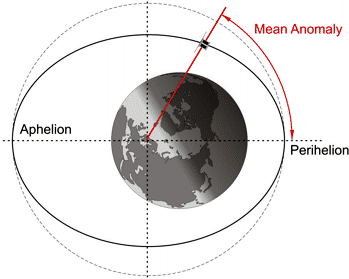

























 Mean Anomaly:
Mean Anomaly:
The Mean Anomaly represents the angle describing the satellites
position in its orbital path. The angle is given measured from
perigee, where it is zero, and referenced to a circular orbit with radius equal to the
orbits semi major axis.
The mean anomaly in the TLE is the orbital position of the satellite at
epoch time.
Mean Motion at Epoch:
The Mean Motion consists of the number of revolutions, which the satellite completes
per day.
Revolution Number at Epoch:
The last parameter in the TLE gives the number of the orbit at the
epoch time, when the TLE was taken.
Other Parameters
Two other important parameters used in orbital calculations are the
Universal Gravitational Constant and Earth Equatorial Radius.
The Universal Gravitational Constant µ is a parameter describing a
planets gravitational force which is acting on the satellite. In case
of the Earth it is equal to 3.986005×1014m3/s2.
The second parameter describes the Earths mean radius at the equator
EEarthEq and it is approximately equal to 6378.140km.
Julian Date
A very common time format when dealing with astronomical calculations
and satellite orbit propagations is the Julian Date.
It is counted in days plus a fraction of the day, which begins at noon
universal time. The Julian Date is counted in days since the 1.st of
January 4713 BC at noon universal time.
Conversion of Gregorian calendar date to Julian date for years AD 1801-2099 can be carried out
with the following formula:

Where y is the year (1801 <= y <= 2099), m is the month (1 <= m <= 12), d is the day of the month
(1 <= d <= 31), and UT is the universal time in hours.
The sign function serves to extract the algebraic sign from a number.
Examples: sign(247) = 1; sign(-6.28) = -1.
The truncation function trunc extracts the integral part of a number.
Examples: trunc[17.835] = 17; trunc[-3.14] = -3.
The formula given above was taken from the U.S. Naval Observatory’s no-longer- published
Almanac for Computers for year 1990.














